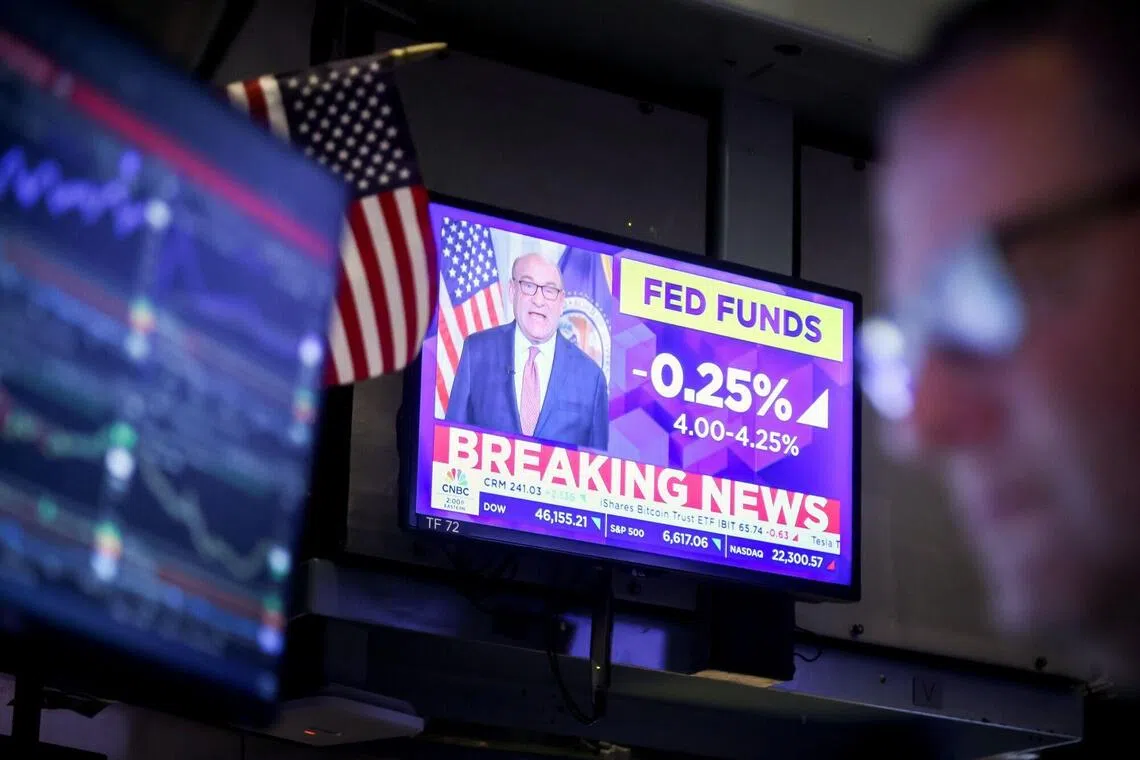US Federal Reserve makes first rate cut of 2025 on employment risks
Sign up now: Get ST's newsletters delivered to your inbox

A television at the New York Stock Exchange broadcasting the US Federal Reserve's decision to cut interest rates, on Sept 17.
PHOTO: BLOOMBERG
Follow topic:
- The US Federal Reserve cut interest rates by 25 basis points to 4%-4.25%, the first cut this year, due to concerns about slower job gains and employment risks.
- Stephen Miran dissented, favouring a larger 50-point cut, while the Fed projects 1.6% growth for 2025, up from 1.4% in June, keeping other forecasts unchanged.
- Political pressure from Trump, Miran's appointment, and Cook's legal battle raise concerns about the Fed's independence, potentially leading to "suboptimal" economic outcomes.
AI generated
WASHINGTON - The US Federal Reserve on Sept 17 lowered interest rates for the first time in 2025, flagging slower job gains and risks to employment as policymakers face heightened pressure under President Donald Trump.
The Fed cut the benchmark lending rate by 25 basis points, to a range of between 4 per cent and 4.25 per cent, while pencilling in two more cuts for 2025.
Fed chairman Jerome Powell stressed that the central bank remains “strongly committed” to maintaining its independence from politics, however, when asked about the addition of a key adviser to Mr Trump among its ranks this week.
He added that the Fed was “right to wait and see how tariffs and inflation and the labour market evolved” before lowering rates for the first time in nine months.
Only new Fed governor Stephen Miran
The other 11 voting members of the rate-setting Federal Open Market Committee supported the quarter-point cut.
Economics professor Ryan Chahrour from Cornell University said the vote appeared to signal “consolidation” among top Fed officials.
“They want to be clear that they’re not influenced by political considerations, and I think they understand that lots of dissent in multiple directions sends a confusing message to markets,” he told AFP.
‘Stark divide’
Fed projections, however, reveal a “stark divide” on the need for additional cuts in 2025, said economist Michael Pearce from Oxford Economics.
Among 19 Fed officials assessing the path of monetary policy, seven projected no further reductions – even as a narrow majority overall pencilled in two more cuts.
Mr Pearce said such a divide is “unusual”, and expects the October rate decision could again depend on jobs data.
Mr Powell told a press briefing that the Fed’s economic projections should be viewed “through the lens of probability”.
Policymakers walk a tightrope balancing inflation and labour market risks as they mull over changes to interest rates.
On Sept 17, the Fed said “downside risks to employment have risen”, even as inflation has picked up and “remains somewhat elevated”.
It noted that job gains have slowed while the unemployment rate – despite being low – also inched up.
The bank has held rates steady in 2025, until now, as it monitored the effects of Mr Trump’s tariffs on inflation.
But Mr Powell said the pass-through of tariffs to consumers has been slower and smaller than expected.
Navy Federal Credit Union chief economist Heather Long warned: “While there are inflation risks, the bigger risk right now is more Americans losing their jobs and a downward spiral starting towards a recession.”
The Fed lifted its 2025 growth forecast to 1.6 per cent from June’s 1.4 per cent projection, while making no change to unemployment and inflation forecasts.
‘Political attention’
Beyond economic concerns, the Fed faces intensified pressure from Mr Trump in 2025 – with the President repeatedly criticising Mr Powell and calling for major rate cuts.
Besides appointing Dr Miran when another official retired early, Mr Trump in August moved to fire Fed governor Lisa Cook,

New Fed governor Stephen Miran favoured a larger rate reduction of 50 basis points.
PHOTO: REUTERS
Dr Miran’s confirmation – without resigning from the White House Council of Economic Advisers – risks giving a sense of political influence over Fed decisions, EY chief economist Gregory Daco earlier told AFP.
Already, Dr Miran has come under fire from Democratic lawmakers for taking a leave of absence from his White House role rather than stepping down, a decision he attributed to his tenure at the Fed lasting only until Jan 31.
Separately, the legal battle involving Dr Cook – the first black woman on the Fed’s board of governors – could have broader implications for the bank.
A federal appeals court ruled late on Sept 15 that Dr Cook could remain in position while challenging her removal over alleged mortgage fraud.
But the Trump administration plans to appeal – potentially bringing the case to the Supreme Court.
The increased political attention is concerning, Mr Daco said. “History has shown that in times when a central bank is under political influence, the economic outcomes are sub-optimal.”
This could mean higher inflation, lower growth and more financial market volatility. AFP

